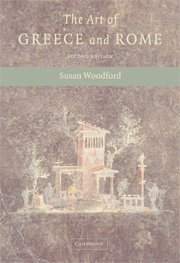Book contents
- Frontmatter
- Contents
- List of Illustrations
- Acknowledgements
- Maps
- Introduction
- PART I THE ARCHAIC AND CLASSICAL PERIODS: PROGRESS AND PROBLEMS
- 1 Free-Standing Statues
- 2 Greek Temples and Their Decoration
- 3 Painting and Painted Pottery
- PART II THE FOURTH CENTURY BC AND THE HELLENISTIC PERIOD: INNOVATION AND RENOVATION
- PART III THE ROMAN WORLD: ADOPTION AND TRANSFORMATION OF THE GREEK LEGACY
- Epilogue
- Appendix: How We Know What We Think We Know
- Glossary
- Further reading
- Index
2 - Greek Temples and Their Decoration
- Frontmatter
- Contents
- List of Illustrations
- Acknowledgements
- Maps
- Introduction
- PART I THE ARCHAIC AND CLASSICAL PERIODS: PROGRESS AND PROBLEMS
- 1 Free-Standing Statues
- 2 Greek Temples and Their Decoration
- 3 Painting and Painted Pottery
- PART II THE FOURTH CENTURY BC AND THE HELLENISTIC PERIOD: INNOVATION AND RENOVATION
- PART III THE ROMAN WORLD: ADOPTION AND TRANSFORMATION OF THE GREEK LEGACY
- Epilogue
- Appendix: How We Know What We Think We Know
- Glossary
- Further reading
- Index
Summary
FOUR POPULAR PLANS
The temple seems to us the most characteristic of all Greek buildings, and it would be natural to conclude that the Greeks regarded such buildings as requirements for the worship of their gods and goddesses. In fact, nothing more than an open-air altar was really necessary. However, once the Greeks began to make statues of their deities, they had to provide a shelter to protect them, and it was to serve this function that a temple was constructed. It was not built to accommodate a congregation, since religious ceremonies and rituals still took place at an altar outside the front (usually the east end) of the temple, and few people ever went inside.
A temple, whether made of wood or stone, could be very simple. A single room entered through a porch would suffice (Fig. 33). The room in which the statue of the god was kept was called a naos (the Romans called it a cella, and this term is sometimes also used of Greek temples). The porch was called a pronaos (literally ‘in front of the naos’).
When a temple could easily be seen from more than one side, the Greeks disliked having the front and the back look different, so they added another porch at the rear (Fig. 34). There was usually no way into the temple from the back porch (called the opisthodomos); its only purpose was to give the temple a more symmetrical appearance.
- Type
- Chapter
- Information
- The Art of Greece and Rome , pp. 23 - 37Publisher: Cambridge University PressPrint publication year: 2004



